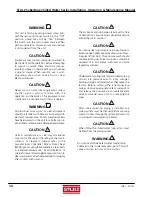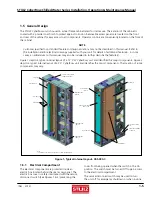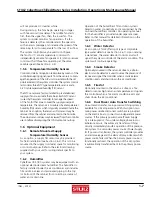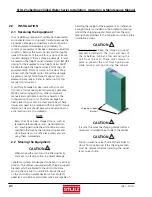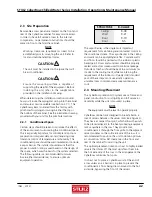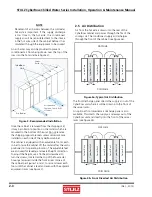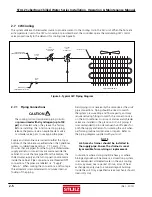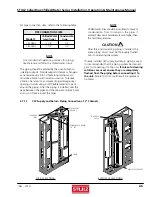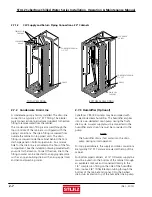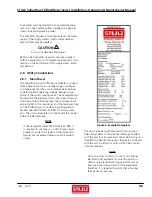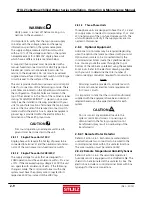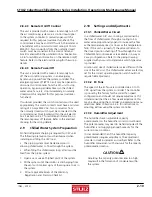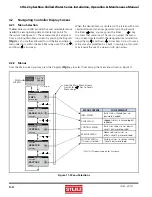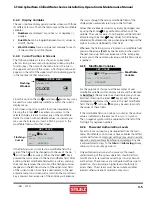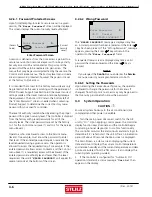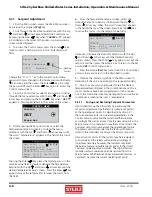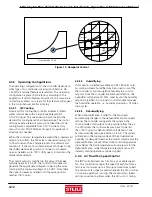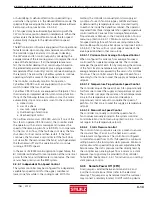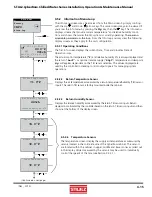
(Dec., 2013)
STULZ CyberRow Chilled Water Series Installation, Operation & Maintenance Manual
3.0 START-UP/COMMISSIONING
3.1 Initial
Operation
For new installations, ensure the unit is ready to oper-
ate by going through the Checklist for Completed
Installation, located in Appendix A, prior to start-up.
NOTE
A Warranty Registration and Start-Up Checklist
is provided in the unit data package. It should
be completed during start-up and sent to STULZ.
This checklist should be used as a guideline for
items that need to be confi rmed during start-up.
Start-up must be performed by a journeyman, refrig-
eration mechanic or an air conditioning technician.
3.2 Step by Step Start-Up Instructions
1. Replace any components and access panels that
were removed during the installation process prior to
performing the start-up checks.
2. Apply power to the system at the service
disconnect switch. Upon applying control power
the
E²
controller begins an initialization sequence,
conducting internal diagnostics to confi rm
functionality (see Section 4.3).
3. After about 20 seconds the Main screen is displayed
(see Figure 7). At the bottom of the screen a status
message “Unit On” appears.
01/01/09 00:00:00
00.0°F
00%rh
RetT 00.0°F dp 00.0°F
Unit On
Figure 7- Main Display Screen
NOTE
You may turn the A/C unit on and off at anytime
by pressing and holding the Enter (
) key for
3 seconds.
4. When “Unit On” appears, the CW valve is signaled
to open. After a 45 second time delay, the fans
begin operating in 5 seconds, time delayed stages
(adjustable). The middle fan is turned on 1st, then the
upper fan, then the lower fan. The STULZ logo in the
display is replaced with a blower
symbol.
5. A 45 second time delay is allowed after the fi rst fan
turns on before the controller polls the air proving
switch. If adequate air fl ow is detected, the control-
ler enables its outputs. If the actual room conditions
are not within the range of the programmed set
points, the system will begin operating in the mode(s)
needed (cooling, humidifying, dehumidifying) to
reach the set points. Symbols appear in the display to
indicate the active operating modes (see Section 4.3).
6. Temperature and humidity alarms are masked out
for 30 minutes to allow for conditions to stabilize
without triggering nuisance alarms.
7. Ensure that all fans are rotating correctly and freely
without any unusual noise.
8. Test cooling operation by decreasing the temperature
setpoint (see Section 4.5.4.1) to create a demand for
cooling. The chilled water valve should open and the
supply air should feel cooler than the return air.
9. Test humidifi cation operation (if applicable)by
raising the humidity setpoint to create a demand
for humidifi cation. Use an amp meter to determine
current draw of the humidifi er. Visually check for
vapor leaving the steam head or feel if the cylinder
is warm to verify if the humidifi er is operational.
In all cases, 1 to 6 hours might be required to see
the desired temperature and humidity level in the
conditioned space. Once room conditions have been
programmed or set, a repeat visit to the conditioned
space may be required to ensure the system is meeting
the room’s requirements.
10. Fill out the applicable sections of Warranty
Registration and Start-Up Checklist.
3.3 Microprocessor Controller
Programming
The
E²
microprocessor controller is factory programmed
based on the features selected with the system. A user
provided BMS may be used to directly interface to the
E²
controller. The operator may view all the available
menu screens through a BMS, however, changes may
be made only to basic parameters such as adjusting
set points and setting and acknowledging alarms.
More advanced parameter adjustments may be made
through the user interface display (see Figure 8).
Operating instructions for the
E²
controller are provided
in Section 4.0.
3-1

